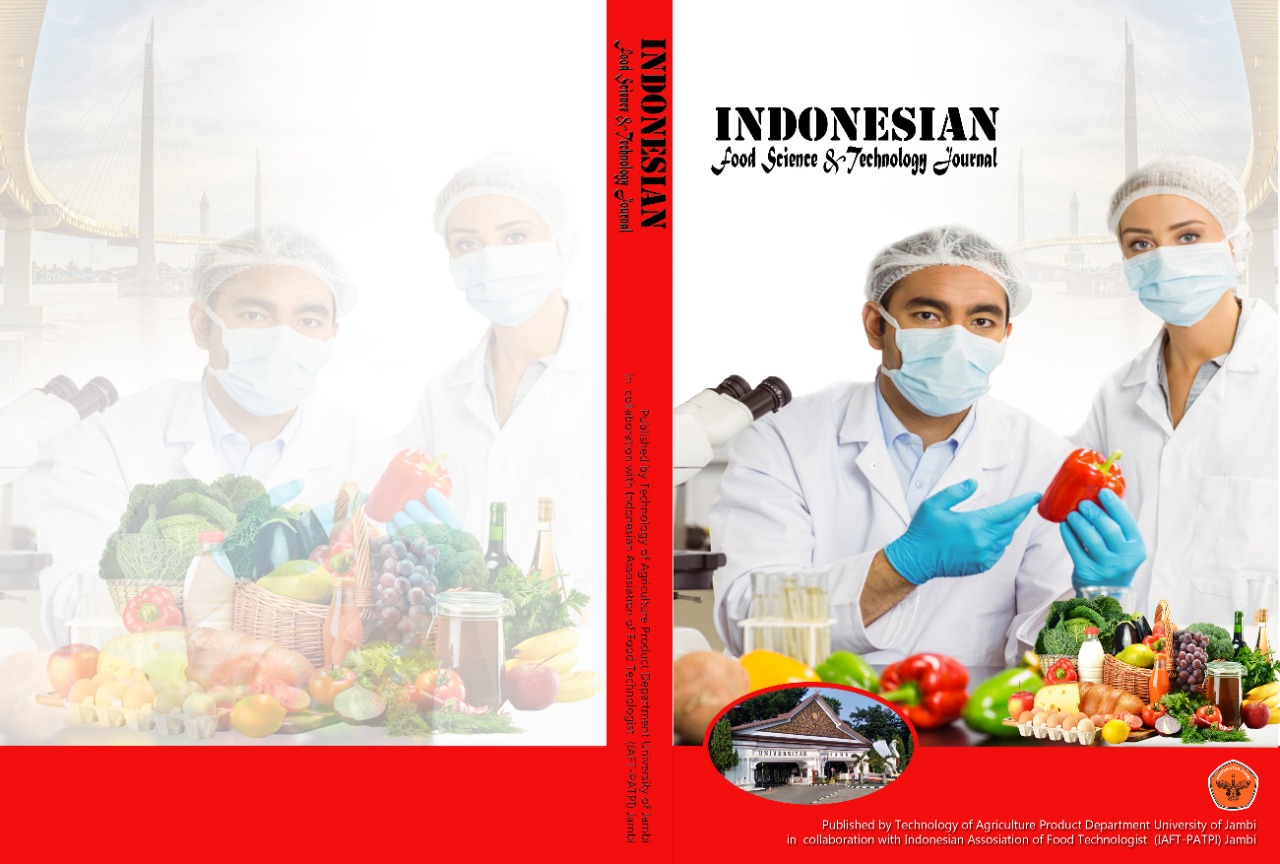Effect of Partial Replacement of Soybean with Chickpea to the Nutritional and Textural Properties of Tofu
DOI:
https://doi.org/10.22437/ifstj.v4i2.11269Keywords:
tofu, soybean; chickpea; texture; nutritional propertiesAbstract
Abstract— Tofu is an oriental food that originated from China and later became a traditional cuisine in many South East Asia Countries, e.g. Indonesia, Singapore, and Thailand. The tofu was made by coagulating soy milk with salt to form curds, which further compress to form a solid block. Tofu usually uses soybeans as the main ingredients; however, in this experiment, the soybeans were partially replaced with chickpeas to increase the amount of dietary fibre and reduce fat levels in the final products. The tofu was made of soybean and chickpea at a ratio of 100:0 (control), 90:10, 80:20 and, 70:30. The products were evaluated based on their nutritional contents (crude protein, crude fat, and crude fibre), and textural properties using Texture Profile Analysis. Some analytical parameters, such as pH, moisture content, and colour were also studied. Partial replacement of soybean with chickpea decreased overall crude protein and fat content, whereas increased crude fibre. The presence of chickpea in the blends, up to 30% (w/w), had affected the tofu curd's protein stability, lowered their pH, and moisture content. A denser tofu curd was obtained by adding more chickpea to the product. The 70:30 blend has the highest hardness value compared to the other formulations. This low soy content mixture, however, can not produce a cohesive and springy tofu gel. The CIELAB colour space of the soybean/chickpea tofu cubes records a trend of increase in redness and yellowness values for tofu with chickpea.
Downloads
References
AACC (2000). Approved Methods of the American Association of Cereal Chemist 10th Edition, AACC Press, St Paul MN.
Burssens, S., Pertry, I., Ngudi, D. D., Kuo, Y., Van Montagu, M. and Lambein, F. (2011). Soya, Human Nutrition and Health, Soybean and Nutrition, Prof. Hany El-Shemy (Ed.), ISBN: 978-953- 307-536-5, InTech, Available from:
http://www.intechopen.com/books/soybean-and-nutrition/soya-humannutrition-and-health (pp. 157-180).
Cai, R., Klamczynska, B., and Baik, B. K. (2001). Preparation of bean curds from protein fractions of six legumes. Journal of Agricultural Food Chemistry. 49(6): 3068-3078.
Chikevendu, J. N., Edeh, R. I., and Okoye, E. I. (2018). Chemical and sensory evaluation
Ezeama, C. F., and Dobson, G. N. (2019). Effect of coagulants on the physicochemical properties of fresh tofu. African Journal of Food Science. 13(2), 287-296.
Ionescu, A., Aprodu, I., daraba, A., Gurau, G., Baciu, C., and Nichita, A. (2009). Chemical and functional characterization of chickpea protein derivatives. The Annals of the University Dunarea de Jos of Galati Fascicle VI – Food Technology, New Series Year III (XXXIII) Paper presented at the International Symposium Euro - aliment 2009, 9th – 10th of October 2009, Galati – ROMANIA.
Jubayer, M. F., Uddin, M. B., Faruque, M. O. (2013). Standardization parameters for production of tofu using WSD-Y-1 machine. Journal of Bangladesh Agriculture University. 11(2): 307-312.
Kumar, P. Yadav, S., and Singh, M. P. (2000). Possible involvement of xanthophyll pigments in heat tolerance of chickpea (Cicer arietinum L.) Physiology and Molecular Biology of Plants. 26, 1773-1785.
Leiva, J., Rodriguez, V., and Nunoz, E. (2011). Influence of calcium chloride concentration on the physicochemical and sensory characteristics of tofu. Ciencie e Investigation Agraria. 38(3): 435-440.
Onwuka, G. I. (2005). Food Analysis and Instrumentation Theory and Practice. Naphtali Prints. Lagos, pp. 90-139.
Pal, M. ., Derrani, M., and Ayde, Y. (2018). Tofu: popular food with nutritional and health benefits. Food & Beverage Processing. 54-55.
Rickert, D. A., Johnson, L. A., Murphy, P. A. (2006). Functional properties of improved glycinin and β-nglycinin fractions. Journal of Food Science. 69(4), FCT303-FCT311.
Toda, K. Oro, T., Kitamura, K., Hajika, M., Takahashi, K., Nokamura, Y. (2003). Seed protein content and consistency of tofu prepared with different magnesium chloride concentration in six Japanese soybean varieties. Breeding Science. 53, 217-223.
Wallace, T. C., Murray, R., Zelman, K. H. (2016). The nutritional value and health benefits of chickpeas and hummus. Nutrients. 8, 766, doi: :10.3390/nu8120766
Zhao, X. and Zheng, X. 2009. A primary study on texture modification and proteolysis of mao-tofu during fermentation. African Journal of Biotechnology. 8, 2294-2300.
Downloads
Published
How to Cite
Issue
Section
License
Copyright (c) 2021 Naksit Panyoyai, Manisorn Silsin, Jatuporn Khongdan, Vilia Darma Paramita

This work is licensed under a Creative Commons Attribution 4.0 International License.







